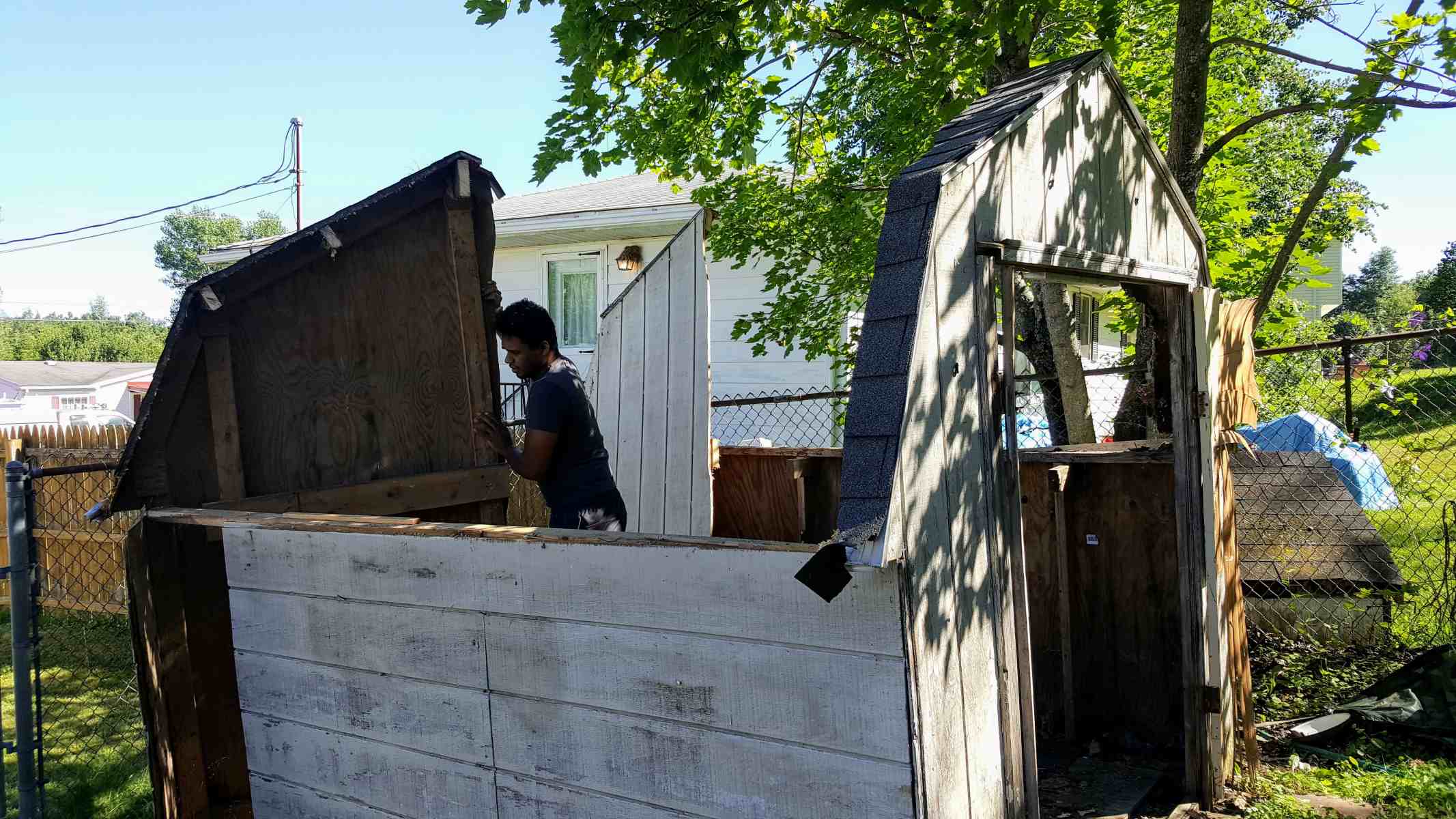Home>Home and Garden>The Ultimate Guide To Removing And Demolishing Sheds


Home and Garden
The Ultimate Guide To Removing And Demolishing Sheds
Published: January 16, 2024
Discover the best techniques for removing and demolishing sheds in this comprehensive guide. Get expert tips and advice for your home and garden projects.
(Many of the links in this article redirect to a specific reviewed product. Your purchase of these products through affiliate links helps to generate commission for Regretless.com, at no extra cost. Learn more)
Table of Contents
Introduction
Removing or demolishing a shed can be a daunting task, but with the right approach and knowledge, it can be a manageable and even rewarding project. Whether you're looking to make space for a new structure, revamp your outdoor area, or simply get rid of an old, dilapidated shed, this ultimate guide will walk you through the process step by step.
Sheds come in various shapes, sizes, and materials, and each one presents its own unique challenges when it comes to removal or demolition. From wooden sheds to metal or plastic ones, the approach may differ, but the fundamental principles remain the same. By understanding the intricacies of this process, you can ensure a smooth and efficient shed removal or demolition, while also minimizing potential risks and complications.
In this comprehensive guide, we will delve into the essential steps involved in removing or demolishing a shed. From assessing the shed and obtaining necessary permits to disconnecting utilities, dismantling the shed, and disposing of debris, each phase will be thoroughly explored. By the end of this guide, you will have a clear understanding of the entire process and be well-equipped to tackle your shed removal or demolition project with confidence.
So, whether you're a seasoned DIY enthusiast or a homeowner looking to embark on your first demolition project, this guide is tailored to provide you with the knowledge and insights needed to carry out the task effectively. Let's dive into the intricacies of shed removal and demolition, and empower you to transform your outdoor space with skill and precision.
Read more: The Ultimate Guide To Removing Wood Stain
Assessing the Shed
Before embarking on the removal or demolition of a shed, it is crucial to conduct a thorough assessment of the structure. This initial step sets the foundation for the entire project, providing valuable insights into the shed's condition, construction, and any potential challenges that may arise during the process.
Understanding the Shed's Construction
Begin by closely examining the shed's construction and materials. Note the type of foundation it sits on, whether it's concrete, gravel, or simply placed on the ground. Assess the framing material, whether it's wood, metal, or another substance, as well as the type of siding and roofing materials used. Understanding these details will help determine the tools and techniques required for the removal or demolition process.
Evaluating Structural Integrity
Inspect the overall condition of the shed, paying close attention to any signs of damage, rot, or structural weaknesses. Look for water damage, mold, or pest infestations, as these issues can significantly impact the removal process. Additionally, assess the stability of the shed to determine if it poses any safety risks during dismantling or demolition.
Identifying Utilities and Obstructions
Take note of any utilities connected to the shed, such as electrical wiring, plumbing, or gas lines. It's essential to identify and safely disconnect these utilities before proceeding with the removal or demolition. Additionally, assess the surrounding area for any potential obstructions, such as overhanging branches, nearby structures, or landscaping features that may impede the process.
Documentation and Planning
Document the dimensions of the shed and its proximity to property lines, neighboring structures, and utility lines. This information will be valuable when obtaining permits and ensuring compliance with local regulations. Furthermore, sketch a rough layout of the shed and its surroundings to aid in the planning and organization of the removal or demolition process.
By thoroughly assessing the shed, you gain a comprehensive understanding of the project's scope and requirements. This knowledge will inform subsequent steps, such as obtaining permits, clearing the area, and disconnecting utilities, setting the stage for a well-executed shed removal or demolition.
Obtaining Necessary Permits
Before commencing the removal or demolition of a shed, it is imperative to secure the required permits from the relevant local authorities. Permit regulations vary by location, and failure to adhere to these requirements can result in legal repercussions and project delays. Here's a detailed look at the crucial steps involved in obtaining necessary permits for shed removal or demolition.
Research Local Regulations
Begin by researching the specific permit requirements for shed removal or demolition in your area. Contact the local building department or visit their website to access the pertinent information. Familiarize yourself with the documentation and application processes, as well as any associated fees. It's essential to understand the zoning regulations, setback requirements, and any restrictions related to shed removal within your locality.
Permit Application
Once you have a comprehensive understanding of the permit requirements, proceed to complete the permit application as per the guidelines provided by the local authorities. The application typically includes details such as the property address, shed dimensions, proposed removal or demolition methods, and the intended use of the cleared space. Ensure that the application is filled out accurately and include any necessary supporting documents, such as property surveys or shed construction plans, as per the specified requirements.
Submission and Review
Submit the completed permit application along with any accompanying documents to the designated department or office. The authorities will review the application to verify compliance with local regulations and building codes. During this phase, it is essential to be responsive to any requests for additional information or modifications to the application. Timely and thorough communication with the permitting agency can expedite the review process and prevent unnecessary delays.
Permit Approval
Upon successful review and compliance verification, the local authorities will issue the necessary permits for the shed removal or demolition. It is crucial to carefully review the approved permits to ensure accuracy and to understand any specific conditions or restrictions associated with the project. Keep the permits readily accessible at the project site, as they may need to be presented during inspections or in the event of inquiries from regulatory authorities.
Compliance and Inspections
Throughout the shed removal or demolition process, it is imperative to adhere to the conditions outlined in the approved permits. Additionally, be prepared for scheduled inspections by building officials to verify compliance with safety and environmental standards. Adhering to the approved permits and cooperating with inspection requirements is essential to ensure a smooth and legally compliant shed removal or demolition.
By diligently following the necessary steps to obtain permits, you can embark on the shed removal or demolition process with confidence, knowing that you are in compliance with local regulations. Securing the required permits not only ensures legal adherence but also contributes to a structured and organized approach to the project, setting the stage for a successful and hassle-free shed removal or demolition.
Clearing the Area
Clearing the area surrounding the shed is a critical preparatory step that sets the stage for a safe and efficient removal or demolition process. This phase involves creating a clear and accessible workspace, removing any potential obstructions, and implementing measures to safeguard the surrounding environment. Here's a detailed exploration of the essential steps involved in clearing the area for shed removal or demolition.
Read more: The Ultimate Guide To Building Stunning Barns And Large Sheds – Unleash Your Inner Craftsman!
Clearing Vegetation and Debris
Begin by clearing any vegetation, such as bushes, vines, or overgrown grass, that may encroach upon the shed or impede the removal process. Trim back overhanging branches and foliage to create ample clearance around the shed, allowing for unobstructed access during dismantling or demolition. Additionally, remove any accumulated debris, such as fallen leaves, twigs, or other organic matter, from the vicinity of the shed to create a clean and safe working environment.
Securing the Perimeter
Establish a clear boundary around the shed to demarcate the work area and prevent unauthorized access. Use caution tape or temporary fencing to cordon off the designated space, signaling to others that the area is undergoing shed removal or demolition. This precautionary measure helps mitigate safety risks and minimizes disruptions during the project.
Hazardous Material Identification
Inspect the surrounding area for any potential hazardous materials that may require special handling or disposal. This includes identifying and safely removing items such as old paint cans, chemicals, or other substances that pose environmental or health risks. Adhering to proper disposal protocols for hazardous materials is essential to ensure the safety of the removal or demolition crew and prevent adverse impacts on the environment.
Clearing Pathways and Access Points
Evaluate the pathways leading to the shed and ensure they are free from obstacles or impediments. Clear any debris, tools, or equipment that may obstruct the entry and exit points, facilitating seamless movement during the removal or demolition process. Additionally, assess the accessibility of the area for heavy machinery or equipment that may be required for the project, ensuring unobstructed pathways for their maneuverability.
Environmental Considerations
Prioritize environmental considerations during the clearing process, taking care to preserve and protect the surrounding ecosystem. Avoid disturbing natural habitats, such as bird nests or burrows, and exercise caution when handling flora and fauna in the vicinity of the shed. By maintaining environmental awareness and sensitivity, you contribute to the preservation of the local ecosystem while carrying out the shed removal or demolition in a responsible manner.
By meticulously clearing the area in preparation for shed removal or demolition, you establish a safe, organized, and conducive workspace for the ensuing phases of the project. This proactive approach not only enhances operational efficiency but also prioritizes safety, environmental stewardship, and regulatory compliance, laying the groundwork for a successful and conscientious shed removal or demolition endeavor.
Disconnecting Utilities
Disconnecting utilities from the shed is a crucial step in ensuring the safety of the removal or demolition process, as well as complying with regulatory requirements. Before initiating any work on the shed, it is essential to address the disconnection of electrical, plumbing, and gas utilities to mitigate potential hazards and streamline the subsequent phases of the project.
Electrical Disconnection
Begin by turning off the power supply to the shed at the main electrical panel. Locate the dedicated circuit breaker or fuse that controls the electricity flow to the shed and switch it to the off position. Use a voltage tester to verify that the power has been successfully disconnected before proceeding with any electrical work. Once the power is confirmed to be off, carefully remove any electrical fixtures, wiring, or appliances connected to the shed, ensuring that all components are safely disconnected and secured. If the electrical wiring is complex or requires specialized expertise, it is advisable to enlist the services of a qualified electrician to handle the disconnection process.
Plumbing Disconnection
If the shed is equipped with plumbing fixtures, such as sinks, faucets, or drainage systems, it is necessary to shut off the water supply and disconnect the plumbing connections. Locate the shut-off valve that controls the water flow to the shed and turn it off to halt the supply. Drain any residual water from the plumbing lines to prevent leakage or water damage during the removal or demolition. Proceed to disconnect the plumbing fixtures and piping, ensuring that all connections are properly sealed to prevent water seepage. It is advisable to cap or seal off the exposed plumbing lines to prevent potential hazards and facilitate the subsequent stages of the project.
Gas Disconnection
If the shed is serviced by a gas line for heating, cooking, or other purposes, it is imperative to safely disconnect the gas supply to the structure. Contact the gas utility provider or a licensed professional to assist with the proper shut-off and disconnection of the gas line. Follow established safety protocols and guidelines to ensure that the gas supply is securely turned off and that any residual gas in the lines is safely purged. Seal off the disconnected gas lines to prevent gas leaks and safeguard the surrounding area from potential risks.
By systematically disconnecting electrical, plumbing, and gas utilities from the shed, you create a secure and controlled environment for the subsequent phases of removal or demolition. Adhering to proper disconnection procedures not only mitigates safety hazards but also aligns with regulatory requirements, ensuring a compliant and systematic approach to the project. Prioritizing the safe and thorough disconnection of utilities sets the stage for a well-executed shed removal or demolition, fostering a structured and responsible undertaking.
Dismantling the Shed
Dismantling the shed is a pivotal phase that demands careful planning, precision, and the application of appropriate tools and techniques. Whether the shed is constructed from wood, metal, or another material, the dismantling process requires a systematic approach to ensure safety, efficiency, and the preservation of salvageable components. Here's a detailed exploration of the essential steps involved in dismantling a shed:
Preparation and Safety Measures
Prior to initiating the dismantling process, it is imperative to equip yourself with the necessary safety gear, including gloves, eye protection, and sturdy footwear. Clear the immediate area of any debris, tools, or potential hazards to create a safe and unobstructed workspace. Secure any loose components of the shed to prevent unexpected movement or instability during the dismantling process.
Sequential Disassembly
Begin the dismantling process by working in reverse order of the shed's construction. Remove any roofing materials, such as shingles, metal panels, or other roofing elements, starting from the top and working downward. Exercise caution when handling roofing materials to prevent injury and ensure proper disposal or salvage of reusable components.
Proceed to dismantle the walls of the shed, systematically removing siding panels, cladding, or other exterior materials. If the shed is constructed from wood, carefully pry apart the framing members, taking care to avoid splinters and protruding nails. For metal sheds, use appropriate tools to disassemble the metal panels or sections, ensuring that sharp edges are handled safely.
As you disassemble the shed, segregate salvageable materials, such as lumber, metal components, or reusable fixtures, for potential repurposing or recycling. This proactive approach not only minimizes waste but also maximizes the utilization of resources, aligning with sustainable and environmentally conscious practices.
Structural Integrity and Stability
Throughout the dismantling process, prioritize the maintenance of structural integrity and stability. As components are removed, assess the remaining structure for any signs of instability or shifting. Reinforce any vulnerable areas to prevent the risk of collapse or unexpected structural failure. Exercise caution when disassembling load-bearing elements to ensure the safe redistribution of weight and stress within the shed's framework.
Waste Disposal and Recycling
Dispose of dismantled materials in accordance with local regulations and waste management guidelines. Sort and segregate the debris, separating recyclable materials from non-recyclable waste. Consult with local recycling facilities or waste management authorities to determine the proper disposal methods for the dismantled shed components, ensuring compliance with environmental standards and regulations.
By meticulously dismantling the shed with a focus on safety, resource utilization, and environmental responsibility, you contribute to a structured and conscientious approach to the removal process. This phase sets the stage for the subsequent disposal of debris and the potential repurposing of salvageable materials, aligning with sustainable practices and the efficient utilization of resources.
Demolishing the Shed
Demolishing a shed involves the systematic dismantling and removal of the entire structure, typically necessitated by factors such as structural instability, irreparable damage, or the need to clear the space for new construction. This phase of the shed removal process demands careful planning, adherence to safety protocols, and the utilization of appropriate tools and techniques to ensure a controlled and efficient demolition.
Safety Precautions
Prior to commencing the demolition, it is paramount to prioritize safety measures. This includes the use of personal protective equipment such as gloves, eye protection, and sturdy footwear to mitigate the risk of injury. Securing the work area and posting warning signs to prevent unauthorized access is essential. Additionally, ensuring that all individuals involved in the demolition are briefed on safety protocols and emergency procedures contributes to a safe and organized demolition process.
Read more: The Ultimate Hack To Remove My AI Snapchat
Methodical Deconstruction
The demolition process typically begins with the removal of doors, windows, and any external fixtures to facilitate access to the interior of the shed. Subsequently, the systematic deconstruction of the shed's framework and walls ensues, employing appropriate tools such as sledgehammers, crowbars, and power tools as necessary. Careful attention is paid to the controlled dismantling of the structure, minimizing the generation of airborne debris and ensuring the safety of the demolition crew.
Structural Assessment and Stabilization
Throughout the demolition, continuous assessment of the shed's structural integrity is imperative. As components are removed, the remaining structure is evaluated for signs of instability or potential hazards. Reinforcement of vulnerable areas and proactive measures to maintain stability are undertaken to prevent unexpected collapses or hazards during the demolition process.
Waste Management and Disposal
Once the shed is fully demolished, the resulting debris and materials must be managed and disposed of in compliance with environmental regulations. Segregation of recyclable materials from non-recyclable waste is prioritized, facilitating the responsible disposal and potential recycling of salvageable components. Coordination with local waste management authorities and recycling facilities ensures that the demolition waste is handled in an environmentally conscious and sustainable manner.
By meticulously planning and executing the demolition process with a focus on safety, structural integrity, and responsible waste management, a successful and conscientious shed removal is achieved. This phase sets the stage for the subsequent disposal of debris and the potential repurposing of salvageable materials, aligning with sustainable practices and efficient resource utilization.
Disposing of Debris
Once the shed removal or demolition process is complete, the responsible disposal of debris is paramount to ensure environmental stewardship and regulatory compliance. The disposal phase encompasses the systematic management of waste materials generated during the removal or demolition, prioritizing recycling, proper disposal methods, and adherence to local environmental regulations.
Read more: How To Remove Tattoos At Home
Waste Segregation and Sorting
The initial step in the disposal process involves the segregation and sorting of the debris into distinct categories. This includes separating recyclable materials such as lumber, metal components, and salvageable fixtures from non-recyclable waste. By categorizing the debris, the potential for resource recovery and recycling is maximized, aligning with sustainable waste management practices.
Recycling Initiatives
Recyclable materials, including wood, metal, and other salvageable components, are directed to appropriate recycling facilities or processing centers. Coordination with local recycling facilities ensures that these materials are channeled for repurposing, contributing to resource conservation and the reduction of environmental impact. By prioritizing recycling initiatives, the disposal of debris evolves into a proactive effort to minimize waste and promote sustainable resource utilization.
Responsible Waste Disposal
Non-recyclable waste materials are managed and disposed of in accordance with local waste management guidelines and regulations. Proper disposal methods, such as landfill deposition or waste-to-energy facilities, are employed to ensure the safe and compliant handling of non-recyclable debris. Collaboration with waste management authorities facilitates the adherence to established protocols, contributing to the responsible and environmentally conscious disposal of waste materials.
Environmental Compliance
Throughout the disposal process, strict adherence to environmental regulations and standards is upheld. This includes compliance with waste disposal regulations, recycling mandates, and environmental impact assessments. By aligning with regulatory requirements, the disposal of debris is conducted in a manner that prioritizes environmental preservation and minimizes adverse effects on the ecosystem.
Read more: How To Remove A Lipoma Yourself
Post-Disposal Site Restoration
Upon the completion of debris disposal, efforts to restore the site to its pre-demolition or pre-removal state are undertaken. This may involve land reclamation, soil remediation, or landscaping initiatives to rejuvenate the cleared area. By restoring the site, the environmental impact of the shed removal or demolition is mitigated, contributing to the overall sustainability of the project.
By meticulously managing the disposal of debris with a focus on recycling, responsible waste disposal, and environmental compliance, the shed removal or demolition culminates in a conscientious and sustainable endeavor. The disposal phase represents a crucial component of the overall project, reflecting a commitment to environmental stewardship and the ethical management of waste materials.
Conclusion
In conclusion, the process of removing or demolishing a shed entails a series of meticulous steps, each contributing to the overall success and responsible execution of the project. From the initial assessment of the shed's condition and construction to the systematic dismantling or demolition, as well as the conscientious disposal of debris, every phase demands careful planning, adherence to safety protocols, and environmental stewardship.
The comprehensive assessment of the shed, including the evaluation of its construction, structural integrity, and utilities, serves as the foundational groundwork for the subsequent phases. This initial step provides valuable insights into the scope of the project, enabling informed decision-making and strategic planning.
Securing the necessary permits for shed removal or demolition is a critical aspect that ensures legal compliance and adherence to local regulations. The diligent research, application, and approval of permits set the stage for a structured and organized approach to the project, fostering a seamless and legally compliant undertaking.
The meticulous clearing of the area surrounding the shed, as well as the safe disconnection of utilities, contributes to the creation of a secure and controlled workspace. Prioritizing safety, environmental awareness, and regulatory compliance during these preparatory phases sets the foundation for a smooth and efficient removal or demolition process.
The subsequent phases of dismantling or demolishing the shed demand precision, safety consciousness, and environmental responsibility. From methodical disassembly to waste management and recycling initiatives, each step reflects a commitment to sustainable practices and the efficient utilization of resources.
The disposal of debris marks the culmination of the shed removal or demolition process, emphasizing responsible waste management, recycling, and environmental compliance. By prioritizing recycling initiatives and adhering to waste disposal regulations, the project culminates in a conscientious and sustainable endeavor.
In essence, the successful removal or demolition of a shed hinges on a holistic approach that integrates meticulous planning, safety protocols, environmental stewardship, and regulatory compliance. By embracing these principles, homeowners and project stakeholders can navigate the shed removal or demolition process with confidence, ensuring a structured, responsible, and sustainable outcome.






